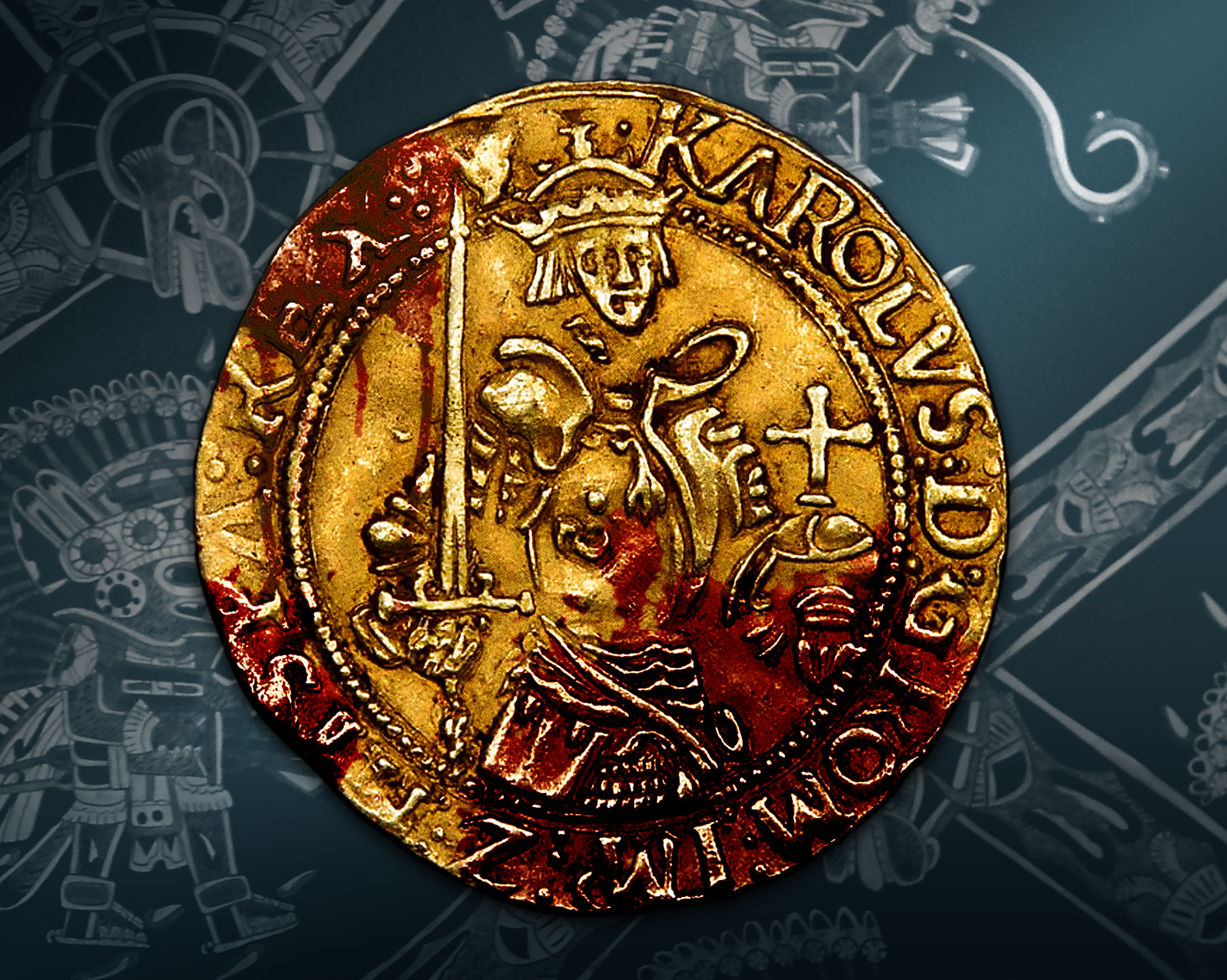When the Spanish arrived in the Americas 500 years ago, they encountered diverse cultures across the continent, including powerful civilisations such as the Mexica and the Incas. This article, first published in issue 40 of In Defence of Marxism magazine (click here to subscribe), takes a look at the material foundations of these rich cultures, their internal contradictions, as well as the conditions of contemporary Spain itself at the time of the conquest. Only by understanding these conditions can we in turn understand the devastation that the conquest wrought, and the wider role of these events in the ascent of capitalism.
The Spanish conquest of the Americas took place 500 years ago. One would think that this is a purely historical event which can be analysed from a distance. But it is not. In fact, it is an important part of the ideology of the ruling class in Spain. Not so long ago, the Peruvian Nobel Prize winner Vargas Llosa said that, “America was a Tower of Babel” of many languages, and as a result, “Americans killed each other”. Even more outrageously, he claimed that this was ‘solved’ by the introduction of the Spanish language, which “united Latin Americans in a great fraternity.”
The official Spanish historiography of the conquest talks of “a meeting of civilisations”, of the Spanish conquistadors bringing culture to the savage natives and peacefully evangelising the Indians into the Christian faith. Furthermore, we are told, this task was carried out by a small band of courageous men against all odds.
This is all rubbish. The Spanish conquest of America was not a “meeting of civilisations” but a bloody affair in which the conquistadors used the most brutal methods of terror to subjugate entire peoples. It was driven by the thirst for gold and loot, and led to the wholesale destruction of indigenous cultures.
What we need is a materialist approach to this historical event. What different cultures and peoples existed on the American continent before the Spanish conquest? What was the character of Spain in the 15th and 16th Centuries? What was the driving force behind the conquest? And what was its outcome?
America
Let us start with the question of the different peoples that existed in America before the Spanish conquest. Their societies were at very different stages of development. It is worth mentioning a few examples. In the north lived the Inuit and Aleut, who lived mainly by hunting polar bears, whales, seals, and walruses, as well as by fishing. Their tools were bone-tipped harpoons, and they lived in igloos. In the northwest, there were the Tlingit, who were fishermen and collectors of plants and wild fruits. They did not know agriculture or the rearing of livestock.
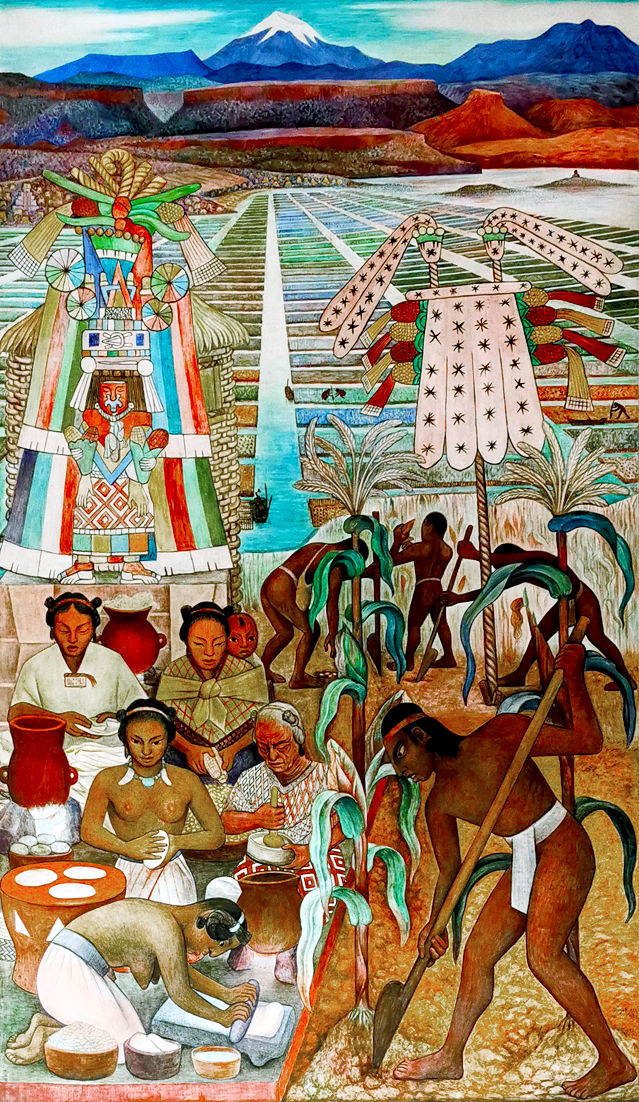 A mural by Diego Rivera depicting the chinampa agricultural raised beds on the lake / Image: public domain
A mural by Diego Rivera depicting the chinampa agricultural raised beds on the lake / Image: public domain
In the northeast, there were the Iroquois and similar groups, studied by the anthropologist Lewis Henry Morgan in the 19th century, whose writings Engels drew upon heavily. They possessed primitive agriculture, collected and hunted, carved wood and stone, and lived in large houses that were shared among several families. In the south of what is now the United States, there were many tribes such as the Comanches and Cheyenes. Their weapons were bows and arrows, and they hunted bison. In the southwest, there were the Pueblo Indians, who planted pumpkin, beans, corn, and cotton through irrigation, and as a result founded villages that brought together around a thousand people. In western North America there lived small hunter-gatherer tribes.
In the Amazon, we find tribes like the Tupi-guaraní and the Kalinago (Caribs) who used wooden weapons. At the southern end of the continent, there were tribes at a very early stage of development, who subsisted by harvesting mollusks, roots, and plants. In the pampas (grasslands in the east of modern-day Argentina and southern Brazil), the tribes hunted guanaco (a relative of the llama) with boleadoras (a throwing weapon made of weights tied to cords).
In almost all of the aforementioned societies that had conquered agriculture and had settled, the basic tasks of society were collectively performed; the land was communally owned; and society was organised on the basis of family groups such as the gens identified by Morgan. Based on such organisation, more elaborate structures could be established, such as fraternities, tribes and peoples, such as the Muiscas (part of the Chibcha language group), who lived in the territory that is now Colombia and were organised in a loose confederation.
Amongst those peoples who had developed agriculture but no private property were the Tainos in the Caribbean islands. This is how they were described by the Italian historian at the service of the Spanish conquest, Pietro Martire d’Anghiera:
“It is proven that amongst them the land belongs to everybody, just as does the sun or the water. They know no difference between meum and tuum [mine and yours - ed], that source of all evils. It is indeed a golden age, neither ditches, nor hedges, nor walls to enclose their domains; they live in gardens open to all, without laws and without judges; their conduct is naturally equitable, and whoever injures his neighbour is considered a criminal and an outlaw.”[1]
But there were also a number of peoples among whom more-complex societies had developed, with social stratification and a state. Agriculture and urban societies emerged independently in different parts of the world; amongst these was the Norte Chico civilisation, in the north of today’s Peru, and the Olmecs, in Mesoamerica.
From the point of view of historical materialism, what is striking is the way in which the same processes have taken place independently in different parts of the world. Once discovered, agriculture gave a powerful impulse to human groups becoming sedentary, building villages and large scale urban settlements, and to the production of a surplus over and above the products necessary to reproduce life. This eventually led to the emergence of class society; starting with the development of a distinct group in society such as a priestly or warrior caste, comprising men freed from the daily struggle for survival who lived off society’s surplus product, which culminated in the establishment of class exploitation and the state.
The same process took place along the Nile river valley, in the Fertile Crescent, the Indus valley and in the North China Plain. Although with a delay, the exact same process took place in the American continent, in the Andean coast and in Mesoamerica. This development was entirely autonomous, taking place among a population that had remained largely isolated from human groups in the Eurasian landmass for tens of thousands of years.
The most advanced civilisations to develop in America prior to the Spanish conquest were the Maya in Central America, the Inca [2] in what is now Peru, and the Mexica – sometimes also referred to as Aztecs [3] – in the Valley of Mexico. They had already developed state structures, and alongside these, a high degree of social stratification, before the Spanish arrived.
At the time of the Spanish conquest, the Maya civilisation had already passed its peak. By the time of the Classic Period (250-900 ce), they had independently developed a writing system, had very advanced astronomy, and a calendar which was more precise than its European contemporary, as Alan Woods explains:
“The Mayans, in addition to their beautiful temples, complex hieroglyphic writing, exquisite jewellery and sculptures, delicate gold and sophisticated works of art, made amazing scientific discoveries, which are as interesting as those of ancient Egypt. They had incredible knowledge about plants and the solar system. Their mathematics were greatly precise. The Mayan accounting system was ahead of the one used in Europe. They used zero and created a vigesimal system (based on 20), separating digits into groups of five units. The surviving manuscripts show that the Mayans had calculated Venus’s orbit around the Sun (584 days). They also calculated the Earth's orbit at 365.2420 days. This is more accurate than the Gregorian calendar used in Europe at the time. Unfortunately, not many of these brilliant manuscripts survived. The Spanish bishop Diego de Landa burned all the Mayan manuscripts and works of art that he could find, because he thought all they contained were superstitions and lies of the devil. What little we have left reveals what the world has lost, as a result of the cultural vandalism by the Church.”[4]
The Inca and Mexica possessed a highly developed agricultural system. They also mined and processed gold and silver, which were used for ornaments. There was a very marked social hierarchy, with warriors, noble families and the religious caste forming distinct, privileged layers. These civilizations dominated their surrounding regions and societies, and extracted tribute from them. A state had already emerged as a centralised body with a life of its own, and collective ownership of the land by the community was under the state’s overall management. The division of labour and specialisation of the different instruments of production also became more marked.
Both the Inca and the Mexica societies had a number of common features. Their mode of production was similar. It was based, at bottom, on the common ownership of the land by the community organised as a kinship group. The Inca called it ayllu, the Mexicas calpulli. Above the local community rose the state, which extracted a share of the surplus product in the form of tribute, in kind or in labour time. This tribute was then used to carry out public works, which were useful for the community, but which each individual community could not have carried out on its own. These included, for instance, irrigation works, food storage silos to provide resilience in periods of crop failure, roads, etc. Of course, the tribute extracted by the state was also used by the priest caste and the ruling state bureaucracy at the top of the state for luxury consumption, and for religious and monumental works which in turn, reinforced their power and authority.
These were complex, developed societies possessing a state, but they were not feudal (where the individual peasant pays tribute and labour services to the individual lord as the owner of the land), and they were not based on slavery (where the individual slave owner is the owner of many slaves, who work the land he owns). This mode of production had many of the features of what Marx and Engels called the ‘Asiatic Mode of Production’. Here, the main production unit was the agricultural commune. There was no private property of the land, and the commune as a whole paid tribute – not to an individual lord but to the state.
The Inca
The Inca civilisation was known as the Tawantinsuyu (‘the four parts’). It rose to prominence in the 13th Century in the Andean highlands. Inca was the name given to the ruling elite, with the Sapa Inka being the supreme ruler, and by extension to the civilisation as a whole. It was built on the remnants of previous societies, particularly the Tiwanako and the Wari. From 1438, under the rule of Pachakutiq Inka Yupanki it began its territorial expansion. At its peak, it reached 3,000 square kilometres, stretching from Colombia to Chile and Argentina, from the edge of the Amazonian jungle in the east to the Pacific Coast in the west, with about 12 million inhabitants in total.
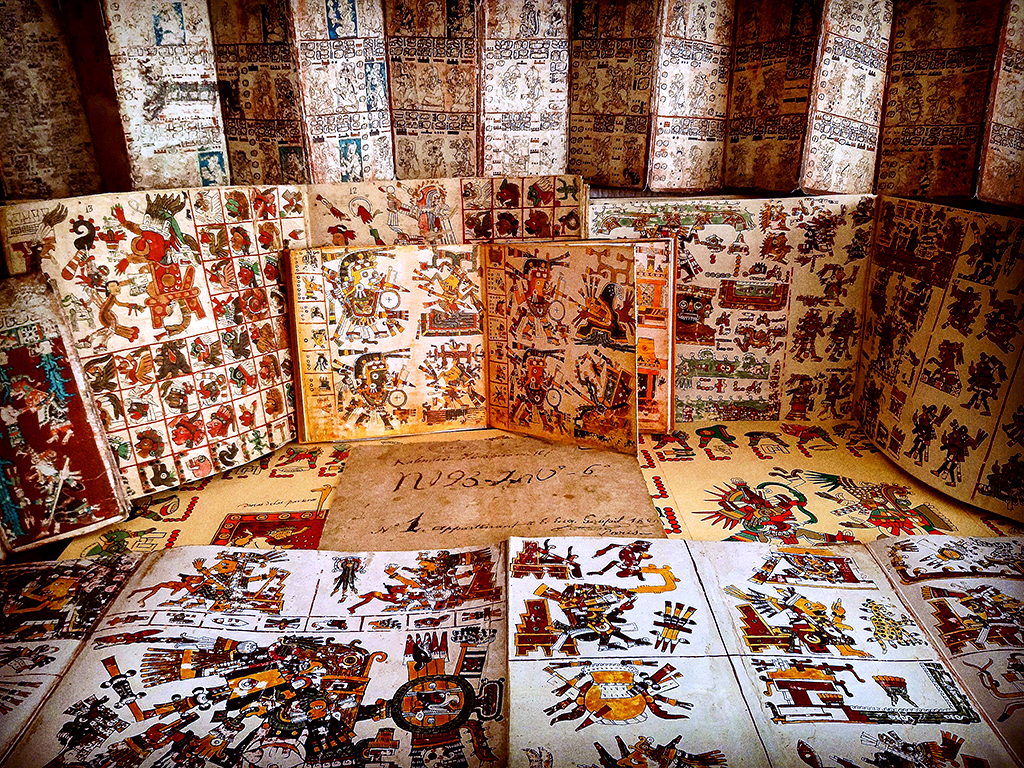 Facsimiles of Mesoamerican pictorial manuscripts. The vast majority were destroyed by the Spaniards / Image: public domain
Facsimiles of Mesoamerican pictorial manuscripts. The vast majority were destroyed by the Spaniards / Image: public domain
Its agriculture was based on terraces along the side of the very high Andean mountains. The state presided over a complex system of irrigation canals and aqueducts, stores of food for use in years of crop failure, the use of fertilisers, selective breeding of different strands of plants and tubers, the use of different ecosystems and exchange between them, and the preservation of food by freezing or drying (a technique known as charqui for meat, from which we derive the word ‘jerk’, and chuño for potatoes).
They had successfully domesticated the llama and the alpaca, which were used for their meat and wool, as well as a means of transportation. They were species that were very well adapted for steep mountain roads, but these roads were not apt for using carts, and so the Incas never developed wheeled transportation.
They possessed an impressive monumental architecture and an elaborate system of roads. They worked gold and silver for ornamental purposes, were advanced in the use of pottery, and were very skilled in cloth making.
The ayllu – that is the village communities at the base of Inca civilisation – paid tribute in labour. The land the ayllu worked was divided into three parts: the produce of one of which was given to the Inca – that is, to the ruling elite; another of which was given to the temple; and a third of which was reserved for the community itself. On top of working on the land of the Inca and the temple, members of the ayllu also provided a certain number of days of work every year (the mit’a) which was used for public works (irrigation, roads, palaces) as well as for warfare.
Altogether, this formed a strict organisation of labour and division of society. There was very little by way of trade. The state bureaucracy redistributed the surplus and organised exchange between different parts of society. Although they did not develop a full writing system, they had the khipu, an elaborate system of knots which were used to keep a record of tribute, the number of people in every ayllu, etc. Recent studies have revealed that this was a very complex form of storing information in a seven-bit binary code. [5]
The Mexica
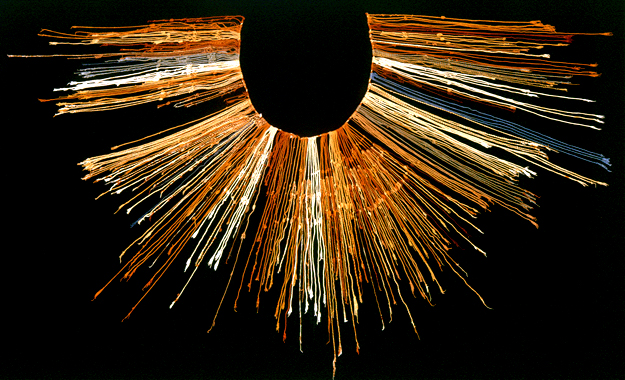 An Inca khipu, a system of strings encoded with knots used for data collection, record-keeping and accounting / Image: Claus Ableiter from enWiki
An Inca khipu, a system of strings encoded with knots used for data collection, record-keeping and accounting / Image: Claus Ableiter from enWiki
According to legend, the Mexica had migrated from the land of aztlán in the north to the central Valley of Mexico, where several peoples had already settled. With most of the nearby land already inhabited by other tribes, the Mexica had to build their city, Mexico-Tenochtitlan, on Lake Texcoco, by recovering land from it, in 1325. This was an awe-inspiring feat of engineering considering the technological level of Mexica society. Their culture drew on the traditions and developments of the societies which preceded them, like the Teotihuacan and the Olmec.
Through a three-city alliance with the nearby Texcoco and Tlacopan, progressively, through armed conflict, they established their dominant position over the other peoples of the region. This Triple Alliance was created in 1427 and reached its peak in 1519. But what was originally an alliance of equals, became completely dominated by the Mexica.
The Mexica based their agriculture on the chinampa, floating islands built on the freshwater lake. They were made from reeds and soil and were extremely fertile, producing up to seven crops a year. This was combined with a system of dykes, ditches and causeways, which regulated the level of the water in the lakes and separated fresh from saltwater.
The highly productive chinampas allowed for the rapid expansion of Tenochtitlan, which became the main power centre of the empire. There is a huge discrepancy in the figures given for the city’s population in 1519, when the Spanish arrived, varying from 80,000 to 300,000. At any rate, this was an enormous city, larger than any contemporary city in Spain. Its population was comparable with the largest cities of Europe at the time, such as Paris (225,000) or Naples (125,000).
Mexica agriculture was based on maize, tomato, sweet potato, cacao, cotton, chilli pepper, pumpkin and climbing beans, among other vegetables. They had inherited the milpa, a very efficient three crop system (maize, climbing beans and squash) from the peoples who preceded them in central Mexico, which allowed them to reduce the time that the land lay fallow. They had also domesticated the turkey.
Unlike the Inca, the Mexica had a very developed system of commerce carried out by a dedicated social group of traders, the pochteca, who also acted as the empire’s spies and agents among other peoples. They probably originated as a calpulli – i.e. one of the kinship groups forming the base of Mexica civilisation – which then specialised and acquired a degree of autonomy and power by virtue of the important role that it played.
The expansion of the Mexica Empire was very rapid. It was based on the extraction of tribute from subjugated peoples. Depending on their level of resistance to the central power, such people were either allowed to retain their own political structures; had a tax collector imposed on them but kept their political structure; or else had direct rule imposed upon them.
Limitations
The American civilisations were faced with a number of constraints. The main one was the lack of large domesticable animals, which could be used for transportation or to draw ploughs for agriculture. The llamas were limited in the amount they could transport, and the terrain of the Andean mountains prevented their use for this purpose. The Mexicas knew the wheel, which they used for toys. But they did not use it for carts and transportation, as they had lacked draught animals. Lake Texcoco allowed fast transportation by canoe. The rest had to be done by hand using a relay system by specialised tameme who carried loads of up to 23kg on their backs, helped by the mecapal, ropes which rested on their heads, for distances of up to 20 km. Neither the Inca nor the Mexica civilisation used the potters’ wheel.
While their ornamental metallurgy was very sophisticated, neither developed iron smelting, and bronze was used only sparsely. Instead, the Mexica used very tough obsidian stone (which is sharper and harder than steel, although it is more brittle and cannot be recast) for their battle weapons.
In general, these societies were heavily based on the exploitation of human labour, rather than on technological development, and this slowed their general development. By the time the Spanish conquistadors arrived, both the Mexica and Inca civilisations seemed to have reached the limit of their territorial expansion, and as a result were riddled with internal contradictions and discontent amongst the recently conquered peoples.
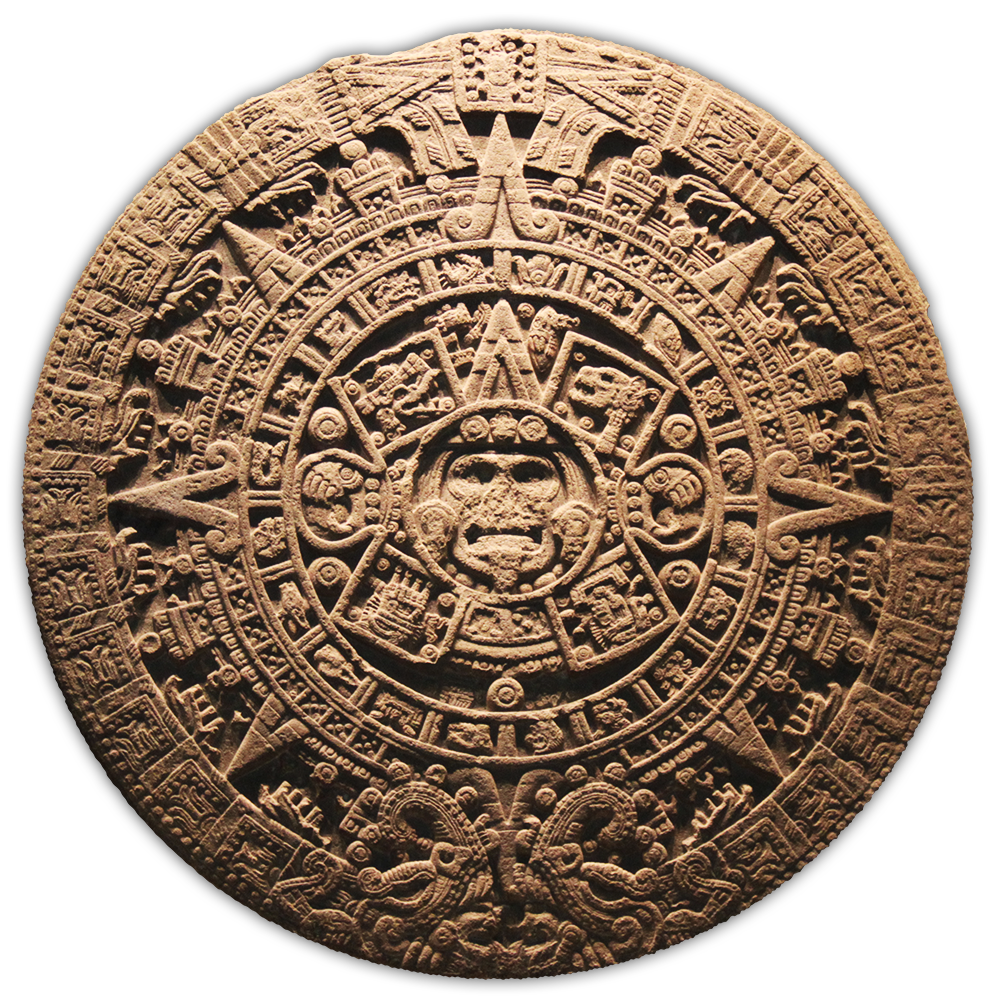 Aztec calendar (Sunstone) / Image: Juan Carlos Fonseca Mata via National Museum of Anthropology, Mexico City
Aztec calendar (Sunstone) / Image: Juan Carlos Fonseca Mata via National Museum of Anthropology, Mexico City
The relationship between the agrarian community at the base of these societies and the state above them was based on mutual benefit. The state extracted surplus from the commune, and in exchange it organised necessary and useful public works. But with the geographic expansion of the state, the cost of maintaining its bureaucracy also grew. Monumental works became increasingly burdensome. What the newly-conquered peoples gained from such domination was increasingly overshadowed by what they lost. The relationship was less and less favourable to the commune.
In both civilisations, there were signs pointing towards the development of private property and slave labour. Among the Mexica, we saw the rise of a class of nobles (pipiltin), who had land allocated to them (pillali) by the supreme ruler, the huey tlatoani; land which was worked by mayeques, peasants who did not belong to any calpulli and were attached to the land, with some features similar to serfs. The land allocated to the pipiltin could be passed down by inheritance, but the pipiltin had to pay services to the huey tlatoani in exchange.
There was another layer of new nobles, tectecutzin, whose status was acquired by outstanding service in war. They too were allocated land (tecpillalli), which was worked by peasants known as tecallec, who were part of a calpulli and who therefore had access to communal land. Instead of paying tribute to the huey tlatoani, however, they paid tribute to the tectecutzin himself, in the form of work on the latter’s land. The tectecutzin, however, could not pass on the land to their descendants.
In both cases, what we see is the supreme ruler – in his capacity as the overall landowner of all the land, including that which was newly conquered – giving concessions of usufruct (the right to use and enjoy the fruits of someone else's property) over certain lands to different groups of nobles, while he himself remained the overall owner as the chief representative of the state. At the same time, it is clear that along this route, a form of private property of the land could have emerged.
There also existed a class of landless peasants among the Mexica, the tlacotin, who were forced to work the land for the state. This could have perhaps developed in the direction of a slave-owning system. But in general, war prisoners were used as human sacrifices.
Similar contradictions, internal forces pushing towards the dissolution of the ownership of the land by the commune, also existed among the Inca.
It is a matter of speculation whether such societies would have evolved towards feudalism or perhaps slavery, were it not for the Spanish conquest. Alternatively, perhaps they would have collapsed under the weight of their own contradictions, reverting back to the agricultural communes, beginning a new cycle leading to the emergence of a new state structure. This had been the case with similar societies which preceded them in the region, notably the Teotihuacan, Tiwanaku and the Maya.
Spain
15th Century Spain was the product of the general development of feudalism in Europe but also had some characteristics peculiar to itself.
The 14th Century had seen a period of crisis for feudal Europe. Crop failures and epidemics had led to discontent and a wave of peasant revolts across Europe that continued into the following century. This eventually led to the emergence of powerful absolute monarchies, which balanced between the rising bourgeoisie in the cities and the feudal nobility. Spain was notable as an early example of this process under Charles I, who was King of Spain from 1516 to 1556, as well as Emperor of the Holy Roman Empire, which he ruled as Charles V.
The period also witnessed the early rise of merchant capital. In Spain, this process was concentrated in Catalonia, part of the Crown of Aragon, which at one point dominated Mediterranean trade.
The unification of Spain came about through the centuries-long war against the Moorish kingdoms. The ‘Reconquista’ was completed in 1492 with the conquest of Granada in the same year that Columbus arrived in the Caribbean. The wars in Spain created a large layer of knights and lower-level noblemen, used to fighting for loot, but generally pauperised. These hidalgos became the backbone of the conquest of America.
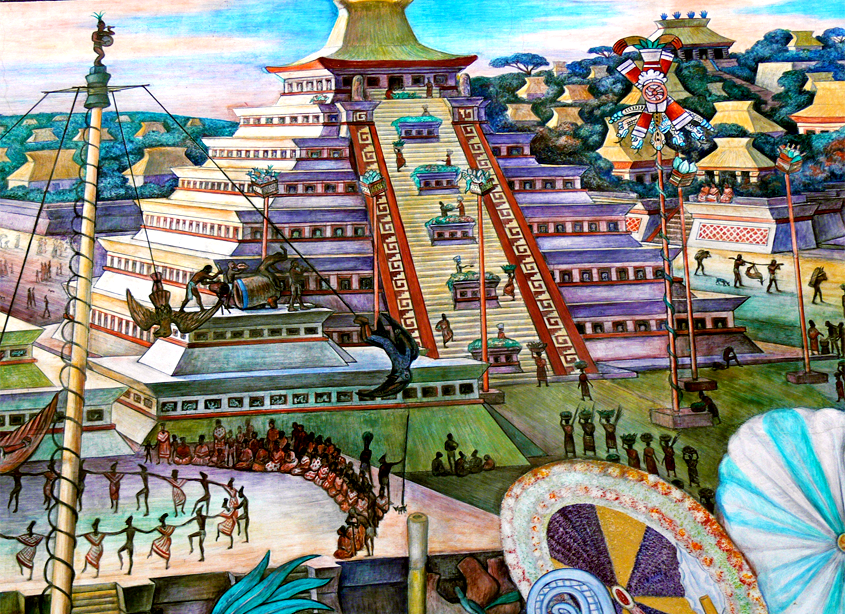 Mural by Diego Rivera depicting life in El Tajín, in the Veracruz region of Mexico / Image: Wolfgang Sauber
Mural by Diego Rivera depicting life in El Tajín, in the Veracruz region of Mexico / Image: Wolfgang Sauber
The wars against the Moors had been conducted under the banner of Christendom. As part of the process of Spanish unification, personified in the marriage of the Fernando King of Aragon and Isabel Queen of Castille, a special institution was created, known as the Holy Inquisition, dedicated to the persecution of religious heresy and infidels. This was to play a significant role in the conquest of the Americas, which was conducted under the flag of the Catholic faith and under the stated aim of evangelising the natives.
The process of Spanish unification coincided in time with the expulsion of the Jews from Spain in 1492, and the persecution, forced conversion and later on the expulsion of the Muslims from Spain as well. In short, Spain was not unified on the basis of a bourgeois revolution, clearing the way for capitalist economic development, but rather on the basis of religious ideological reaction.
So what was it that motivated Columbus’ voyage? He was from Genoa, which had established a powerful maritime merchant Republic, and was searching for a trading route towards China and India through the East. The direct land route had been blocked by the fall of Constantinople in 1453. The whole enterprise was therefore motivated by commercial interest and funded by commercial capital. Above all, it was driven by the search for gold.
Engels explains the process brilliantly:
“How deeply the foundations of the feudality had been weakened and its structure corroded by money around the end of the fifteenth century, is strikingly evident in the lust for gold which possessed Western Europe at this time. It was gold that the Portuguese sought on the African coast, in India and the whole Far East; gold was the magic word which lured the Spaniards over the ocean to America; gold was the first thing the whites asked for when they set foot on a newly discovered coast. But this compulsion to embark on distant adventures in search of gold, however feudal were the forms which it took at first, was nonetheless basically incompatible with feudalism, the foundation of which was agriculture and the conquests of which were directed at the acquisition of land. To this it must be added that shipping was definitely a bourgeois business, a fact which has stamped every modern navy with an anti-feudal character.”[6]
So, the forms that the conquest of America took were feudal. But the content was definitely bourgeois and driven by merchant capital.
Furthermore, it must be explained that the voyage to America and its conquest was made possible by a series of technological developments, which were not at all Spanish. Amongst them were the astrolabe (which made astronomical measurements at sea possible), the compass, and gunpowder (which made possible early, primitive firearms such as the cannon and arquebuses).
The ship that the Spanish used was mainly the carabel, a relatively small but highly manoeuvrable boat that had been developed in the fight against pirates in the Mediterranean, and deployed by the Portuguese in their early exploration and spoliation of Africa and some Atlantic islands. This was supplemented by the larger nao. These ships were equipped with the lateen sail, which allowed them to navigate windward (i.e. against the wind). Portuguese sailors and explorers had also honed the understanding of oceanic currents.
The model for the colonisation of America had been established by the Portuguese colonisation of Atlantic islands.
To this we must add the steel sword and armour, which the Spanish had perfected in centuries of warfare; and the technique of horse riding a la jineta, which they had adopted from the Moors they fought against.
Spain therefore embodied all of these contradictions at the time of the conquest. It was a feudal country, dominated by Catholic obscurantism, but at the same time it was propelled across the Atlantic by the powerful impulse of mercantile capital, which over the centuries had grown in the womb of feudal society, but was antagonistic to it. It was able to carry out the conquest of America by using the accumulated technique and knowledge of the whole of the Eurasian landmass.
Conquest
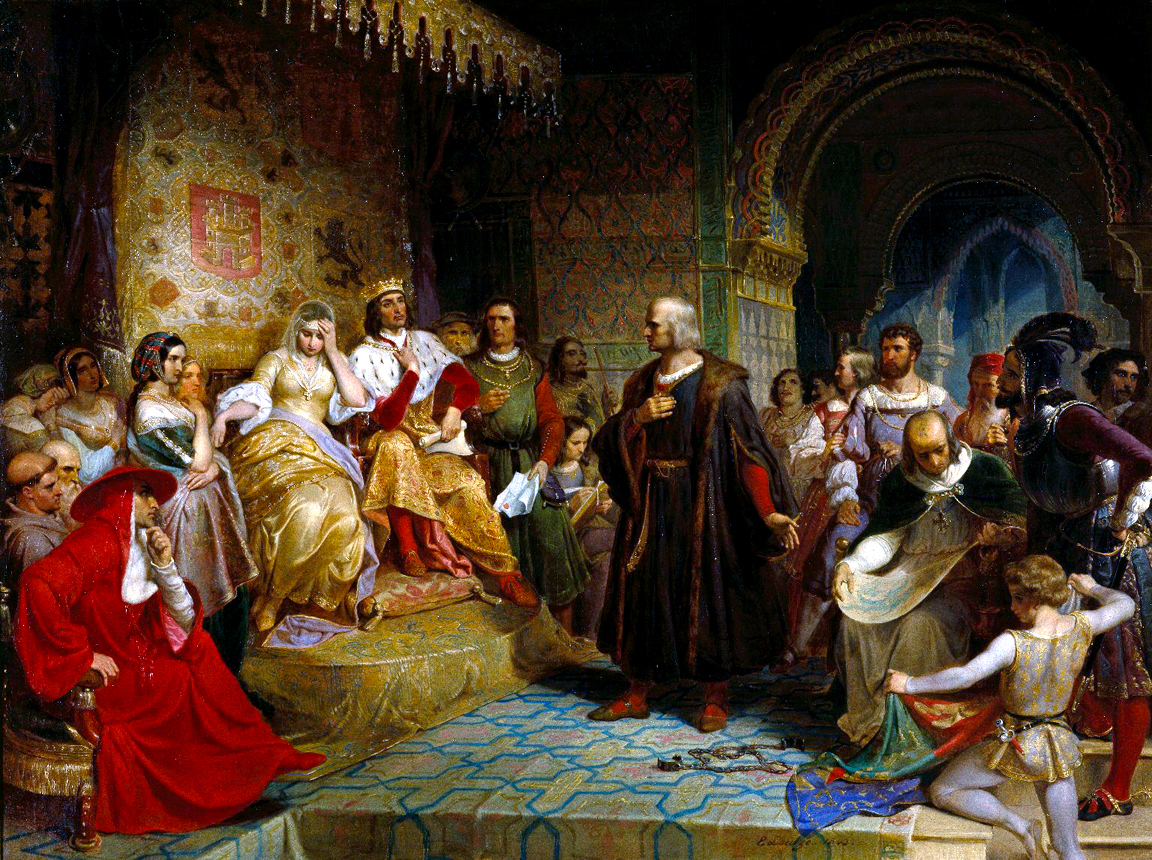 Emanuel Leutze, Columbus Before the Queen (1843) / Image: public domain
Emanuel Leutze, Columbus Before the Queen (1843) / Image: public domain
The conquest itself was a brutal affair. First, the Spanish conquistadors arrived in the Caribbean islands. They enslaved the local populations of the Taíno ‘Indians’ by extremely brutal means. When the Taínos resisted and rebelled, they were massacred. The Spaniards used cruel methods of terror in order to punish the rebels, who were defending their land and livelihood, as a warning to others. They would cut off noses, ears, hands, burn them at the stake, dismember and disembowel them. Amongst the weapons the Spanish used were specially trained mastiff dogs, which would ravage the locals.
The Spanish priest Bartolomé de las Casas wrote an eyewitness account of the horrific methods employed by the Spanish in ‘A Short Account of the Destruction of the Indies’:
“[...] with their horses and swords and lances, the Spaniards easily fended them off, killing them and committing all kind of atrocities against them. They forced their way into native settlements, slaughtering everyone they found there, including small children, old men, pregnant women, and even women who had just given birth. They hacked them to pieces, slicing open their bellies with their swords as though they were so many sheep herded into a pen. They even laid wagers on whether they could manage to slice a man in two at a stroke, or cut an individual’s head from his body, or disembowel him with a single blow of their axes. They grabbed suckling infants by the feet and, ripping them from their mothers’ breasts, dashed them headlong against the rocks. Others, laughing and joking all the while, threw them over their shoulders into a river, shouting: ‘Wriggle, you little perisher.’ They slaughtered anyone and everyone in their path, on occasion running through a mother and her baby with a single thrust of their swords. They spared no one, erecting especially wide gibbets on which they could string their victims up with their feet just off the ground and then burn them alive thirteen at a time, in honour of our Saviour and the twelve Apostles, or tie dry straw to their bodies and set fire to it. Some they chose to keep alive and simply cut their wrists, leaving their hands dangling, saying to them: ‘Take this letter’ – meaning that their sorry condition would act as a warning to those hiding in the hills. The way they normally dealt with the native leaders and nobles was to tie them to a kind of griddle consisting of sticks resting on pitchforks driven into the ground and then grill them over a slow fire, with the result that they howled in agony and despair as they died a lingering death.
“It once happened that I myself witnessed their grilling of four or five local leaders in this fashion (and I believe they had set up two or three other pairs of grills alongside so that they might process other victims at the same time) when the poor creatures’ howls came between the Spanish commander and his sleep. He gave orders that the prisoners were to be throttled, but the man in charge of the execution detail, who was more bloodthirsty than the average common hangman (I know his identity and even met some relatives of his in Seville), was loath to cut short his private entertainment by throttling them and so he personally went round ramming wooden bungs into their mouths to stop them making such a racket and deliberately stoked the fire so that they would take just as long to die as he himself chose. I saw all these things for myself and many others besides. And, since all those who could do so took to the hills and mountains in order to escape the clutches of these merciless and inhuman butchers, these mortal enemies of humankind trained hunting dogs to track them down – wild dogs who would savage a native to death as soon as look at him, tearing him to shreds and devouring his flesh as though he were a pig. These dogs wrought havoc among the natives and were responsible for much carnage. And when, as happened on the odd occasion, the locals did kill a European, as, given the enormity of the crimes committed against them, they were in all justice fully entitled to, the Spanish came to an unofficial agreement among themselves that for every European killed one hundred natives would be executed.” [7]
At the Jaragua massacre in July 1503 on the island of Hispaniola, 300 conquistadors, led by the Spanish ruler Ovando, massacred the leaders of the Taíno people who were led by Anacaona, a female cacique (chief). The leaders of the Taínos had been summoned to a celebration and were massacred by the Spanish conquerors, 80 of them burned alive and the cacique Anacaona was hanged as a lesson to others.
The intolerable conditions that the locals were subjected to in the mines in the Caribbean led to a massive death toll. Others committed suicide and women aborted their unborn babies. Such were the terrible conditions of slavery that they did not consider it worthwhile to go on living.
The massive extermination of locals in the Caribbean had two important consequences. One was the introduction of slavery in the plantations, which originated with the use of Indian slaves captured in other territories, and moved on to the forced transportation of African slaves with the development of the transatlantic slave trade. The other consequence was the impulse towards looting other lands, west, north and south of the Caribbean islands, leading eventually to the conquest of Mexico.
The question remains: how was it possible for a small number of Spaniards – 400 at the beginning and perhaps 1,100 at the peak – to conquer and subjugate the Mexica, a developed civilisation skilled at warfare? And, bear in mind, this was accomplished in a relatively short campaign, which started in February 1519 and ended in August 1521.
On the side of the Spaniards there was, of course, the element of surprise. The local peoples had never seen horses nor mastiff dogs, never mind their deployment in warfare. They had never experienced firearms, let alone the cannons and arquebuses which the Spaniards had. The Spanish steel swords and lances also gave them an advantage. The different techniques in warfare reflected different aims: using hand-to-hand combat, the locals mainly aimed to capture prisoners, instead of killing their enemy as the Spanish did. The locals fought in large groups, sending wave after wave of fighters to engage in this hand-to-hand warfare. The Spaniards, in contrast, used manoeuvres and tightly-knit squadrons.
Nevertheless, superior weaponry is insufficient to explain how a few hundred Spaniards defeated a large empire with tens of thousands of warriors. And furthermore, some of the Spanish weapons were not so useful in the conditions of America. Gunpowder, for instance, was in short supply and easily became damp in tropical conditions. The arquebus was a very slow weapon to reload, and could only be fired once every two minutes. The Spaniards only had a handful of cannons and a small supply of cannonballs. Steel armour was very cumbersome in the hot and humid local conditions of Mesoamerica. In fact, it was very quickly replaced by the more comfortable local armour, composed of several layers of woven cotton. Technological superiority could only be effective when combined with several other factors.
As mentioned above, Mexica society had already reached its limits by the time the Spanish arrived. The Spaniards, led by the notary Hernán Cortés, skillfully used the internal contradictions of the empire, by allying themselves with the peoples that the Mexica had subjugated.
The first people they encountered when they landed in Yucatán were the Totonac. The Spanish were able to gather intelligence and establish communication through two figures who became very important: Gerónimo de Aguilar, a Spanish priest who had survived the shipwreck of an earlier expedition and lived amongst the Cocomes for eight years and spoke Maya; and Malintzin, a Mexica noble woman who ended up being raised by Maya-speaking people and who therefore spoke Nahuatl and Maya.
Cortés promised to help the Totonac to free themselves from their tribute to Tenochtitlan, but at the same time they told the Mexica ambassadors that Cortés was on their side. It was with the help of hundreds of Totonac warriors from Cempoala that Cortés battled the Tlaxcalans (or Tlaxcaltecas). The Tlaxcalans had been at war with the Mexicas for decades and the Mexicas had imposed an embargo on them. Once the Tlaxcalans witnessed the fighting abilities and weapons of the Spaniards, they decided that they would be useful allies against the Mexica. Gradually other peoples also gravitated into the orbit of the Spanish. These alliances were only possible because these peoples were already at odds with the Mexicas and resentful of having to pay tribute to them.
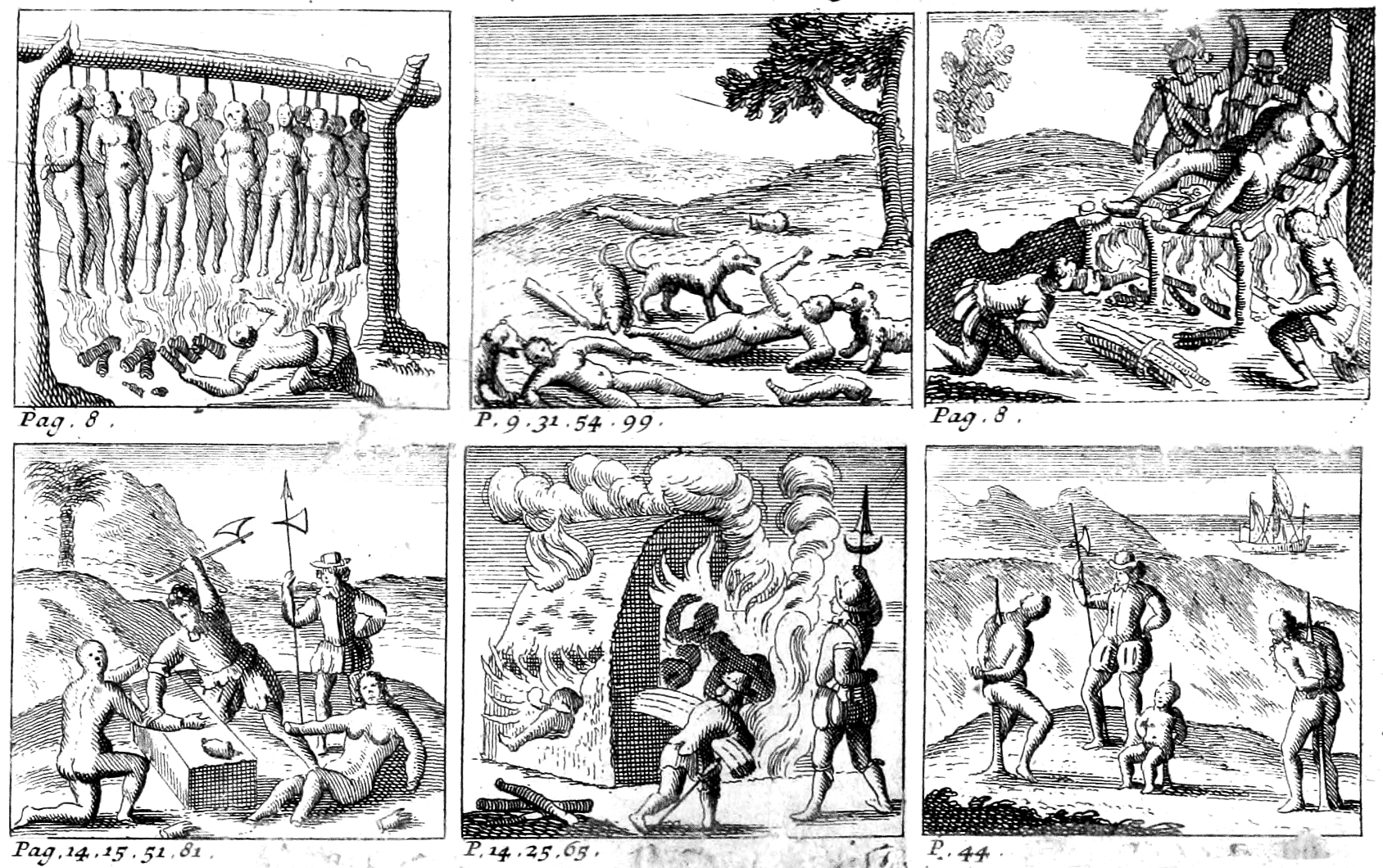 Illustrations from Cruelties by Spaniards on Indians in the Americas, by Bartolome de las Casas / Image: public domain
Illustrations from Cruelties by Spaniards on Indians in the Americas, by Bartolome de las Casas / Image: public domain
The internal contradictions of the Mexica empire therefore played an important role. But, again, the factor of alliances cannot explain everything on its own. Why did these local peoples choose to ally themselves with the conquistadors? Because they saw that they were very effective at fighting.
In order to solidify these alliances, Cortés used methods of terror. The most important example of this was the Cholula massacre. Once he had allied with the Tlaxcaltecas, he decided to teach the neighbouring Cholula a lesson. This was in order to enhance his reputation with the Tlaxcaltecas but also to send a message to Moctezuma, the supreme ruler of the Mexicas.
The massacre of Cholula started when Cortés accused the former of preparing a betrayal on behalf of the Mexicas. He ordered the local leaders into the town square and then the massacre started. This is how it was described by a Spanish chronicler:
“[Cortés] had the shotgun fired, which was the signal: and all the Spaniards and their friends attacked the people of the town with great impetus and anger. They did according to the difficulty they were in, and in two hours they killed more than six thousand. Cortés ordered that they not kill children or women. They fought for five hours, because, since the townspeople were armed and the streets were barricaded, they had defence. They burned all the houses and towers that were resisting. They drove out the whole neighbourhood; They were stained with blood. They stepped on nothing but dead bodies. They climbed the main tower, which has one hundred twenty steps, up to twenty knights, with many priests from the same temple; which with arrows and stones did a lot of damage. They were required, but they did not surrender, and so, they burned with the fire that they lit… The city was looted. Ours took the plunder of gold, silver, and feathers, and our friendly Indians a lot of clothing and salt, which was what they most wanted, and they destroyed as much as possible, until Cortés ordered them to stop.”[8]
When Cortés entered Mexico-Tenochtitlan, the capital of the Mexica, for the first time, his army consisted of 350-400 Spaniards, 8,000 Tlaxcaltecs, 2,000 Totonac, and other minor forces of Otomis and Huejotzingos.
Moctezuma was seized by the conquistadors. Formally, he was still the supreme ruler, but de facto he was under house arrest and controlled by the Spanish and their allies. In May 1520, Cortés left Tenochtitlan to go to Veracruz to defeat an army sent by the governor of Cuba to subdue him. In his absence, Cortés’ lieutenant, Pedro de Alvarado, organised a massacre of the Mexica nobility, taking advantage of the celebrations of the Tōxcatl festival at the Huēyi Teōcalli (Great Temple). This provoked a Mexica uprising, and the Spaniards and their allies were forced to flee the city with great loss of life.
Cortés then decided to lay siege to Mexico-Tenochtitlan, having won to his side most of the cities surrounding the lake that had previously been tributaries to the Mexica. At this point, the army gathered by Cortés had about 800 Spaniards and tens of thousands of warriors from allied peoples. Some Spanish chroniclers place the figure at 100,000 allied warriors, though that is likely to be an exaggeration.
The brutal siege of the city on the lake began in January 1521 and lasted nearly eight months. As the conquistadors and their allies advanced, more peoples joined them. The Mexica resisted valiantly, led first by Cuitlahuac (Moctezuma’s brother) and then by Cuahtemoc (Moctezuma’s cousin). The Spaniards organised the building of 13 brigantines, which gave them an advantage on the lake when faced with Mexica canoes. The final, bloody defeat of Mexico-Tenochtitlán was on 13 August 1521.
The question of the quality of leadership also entered the equation. Cortés was cunning – a skilled politician and maneuverer, driven by the thirst for loot. Moctezuma, on the other hand, seems to have been indecisive at crucial moments. This indecision was partially the result of the internal contradictions of the Mexica political structure.
It is also important to mention the role of disease in the Spanish conquest. The Spaniards brought a whole series of infectious diseases, which were unknown in the Americas, amongst them smallpox and measles. These diseases had mainly jumped from domestic animals, species of which were unknown in the Americas, to humans. Europeans had been used to epidemics for centuries and had developed a degree of immunity, but the locals in America had never been exposed to them. As a consequence, mortality rates were extremely high, perhaps reaching 80 or 90 percent. This wasn’t crucial in the siege of Tenochtitlan, as it affected both the Mexicas and the Spanish allies. But the psychological impact was profound, as the local peoples saw how the Spanish were unaffected, while they died in great numbers.
Perú
Epidemics of Spanish origin played a more important role in the conquest of Perú, however.
This latter conquest took place between 1532 and 1572. Here, the Spanish forces were even smaller. They were led by Pizarro, a particularly ruthless and crude conquistador, and an illiterate to boot. He had fewer than 200 fighters in the crucial battle of Cajamarca in 1532, in which he captured Atahualpa, the last Inca emperor.
In Peru, the epidemic brought by the Spaniards into the Americas had preceded the arrival of the conquistadors, having probably travelled overland from Colombia. Thousands were dying from a previously unknown disease, for which there was no known cure. Imagine the impact of COVID-19, and then multiply it a thousandfold.
Furthermore, Pizarro had arrived in the middle of a civil war over the succession to the late emperor, Huayna Capac. He had died in mysterious circumstances – perhaps from the same smallpox epidemic. The civil war between the brothers Huascar and Atahualpa, which erupted in the wake of Huayna Capac’s death, was skillfully manipulated by Pizzaro who supported first one then the other brother, in order to conquer the Inca empire.
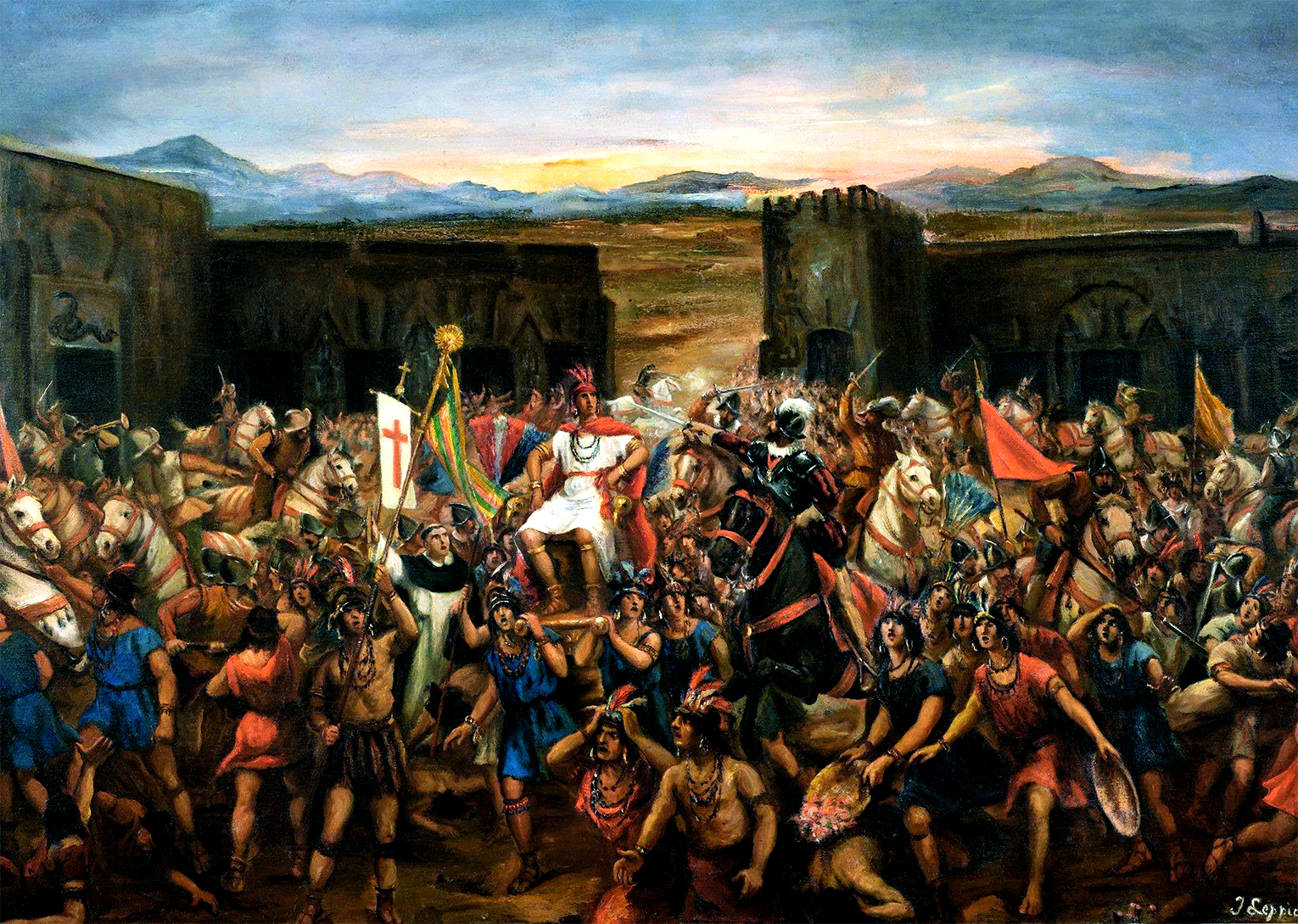 Juan Lepiani, The Capture of Atahualpa in Cajamarca (c. 1920) / Image: public domain
Juan Lepiani, The Capture of Atahualpa in Cajamarca (c. 1920) / Image: public domain
Again, as in the case of the Mexica, the capture of Atahualpa played a crucial role in dominating the Inca. As in the case of the massacre of the Great Temple in Tenochtitlan, the capture took the form of a brutal act of treachery. The Inca were convinced to come into Cajamarca in peace, with an entourage of just 8,000 fighters, out of a total fighting force ten times that size. Once inside a closed square, the largely unarmed gathering was attacked by the Spaniards and massacred. The capture of the Sapa Inka, the main ruler, which was supposed to be the son of the Sun god Inti and was considered as a divine figure, had a tremendous psychological impact, which disoriented and disorganised the Inca resistance.
After the murder of Atahualpa, the Spanish installed a puppet Inca ruler, Tupac Huallpa. But there was a new rebellion, led first by Manqu Inka and then by Túpac Amaru. They established a new Inca state based in Vilcabamba, and it took the Spanish conquistadors decades to defeat it. They could only do so by counting on the support of several local peoples which wanted to shake off the Inca yoke. As the struggle took several decades, the Inca were able to adopt the Spaniards’ warfare methods and techniques, including the use of horses and firearms. But this alone was insufficient to overcome forces that had superior numbers. Finally, in 1572 the Inca abandoned Vilcabamba and fled. Shortly afterwards, Túpac Amaru was captured and, after a mock trial, publicly executed.
The Spanish conquest of the Maya was conducted with similar methods, brutal killings, alliances with local peoples against others, but a number of factors made this a much more difficult campaign. First of all the terrain, thick humid jungle and swamplands was much less favourable to Spanish warfare techniques and provided an advantage to the different Maya peoples who skillfully used ambushes against the invaders. Secondly, the Maya were not ruled by one single empire (as was the case with the Mexica and the Inca), but rather were organised in a series of city states and smaller local and regional kingdoms, which had to be fought and defeated one by one.
Here again, disease played a crucial role in the Spanish conquest. Wave after wave of Old World diseases ravaged the Indigenous peoples of the region, including smallpox, influenza, measles, tuberculosis, malaria, etc. In some cases, disease spread even before direct contact or any fighting had taken place. Some authors calculate that in some regions up to 90 percent of the pre-contact Maya population was wiped out within a century.
Nevertheless, the Spanish were defeated several times and even when they managed to establish control, there were frequent rebellions. Mayan peoples rejected the policy of reducciones, through which the conquistadors re-settled them into new villages, so they could be incorporated into the colonial administration. Many simply fled into more remote areas or to join other groups which had not yet been colonised. The main thrust of the conquest of the Maya took place between 1529 and 1546.
However, there were areas of the Lancandon jungle and the Petén which remained unconquered. In the Lacandon jungle, the Lakandon Chʼol people opposed brave resistance and were joined by many fleeing the invaders. They were not fully defeated until 1696. In the Petén, the local Maya people, the Itza, managed to resist the Spaniards for decades, having first defeated them in the 1620s. Finally a war which lasted between 1695 and 1697 managed to destroy the last of Maya kingdoms. Within a decade, the Indigenous population had collapsed by about 90%, due to a combination of disease, overwork, demoralisation and famine.
The consequences
What were the consequences of the conquest? First of all, a massive destruction of Indigenous peoples and their cultures. The population of the Caribbean islands was wiped out almost completely. The population of the Mexica empire, which had been around 20 million when the Spaniards arrived, collapsed to perhaps 2 million in the course of 70 years. The Spaniards systematically destroyed the temples. Beautiful works of art, which were made of silver and gold, were melted down for transportation and lost forever. The Spanish conquistadors proudly and systematically destroyed the Maya Codices, the folding books containing their history and literature.
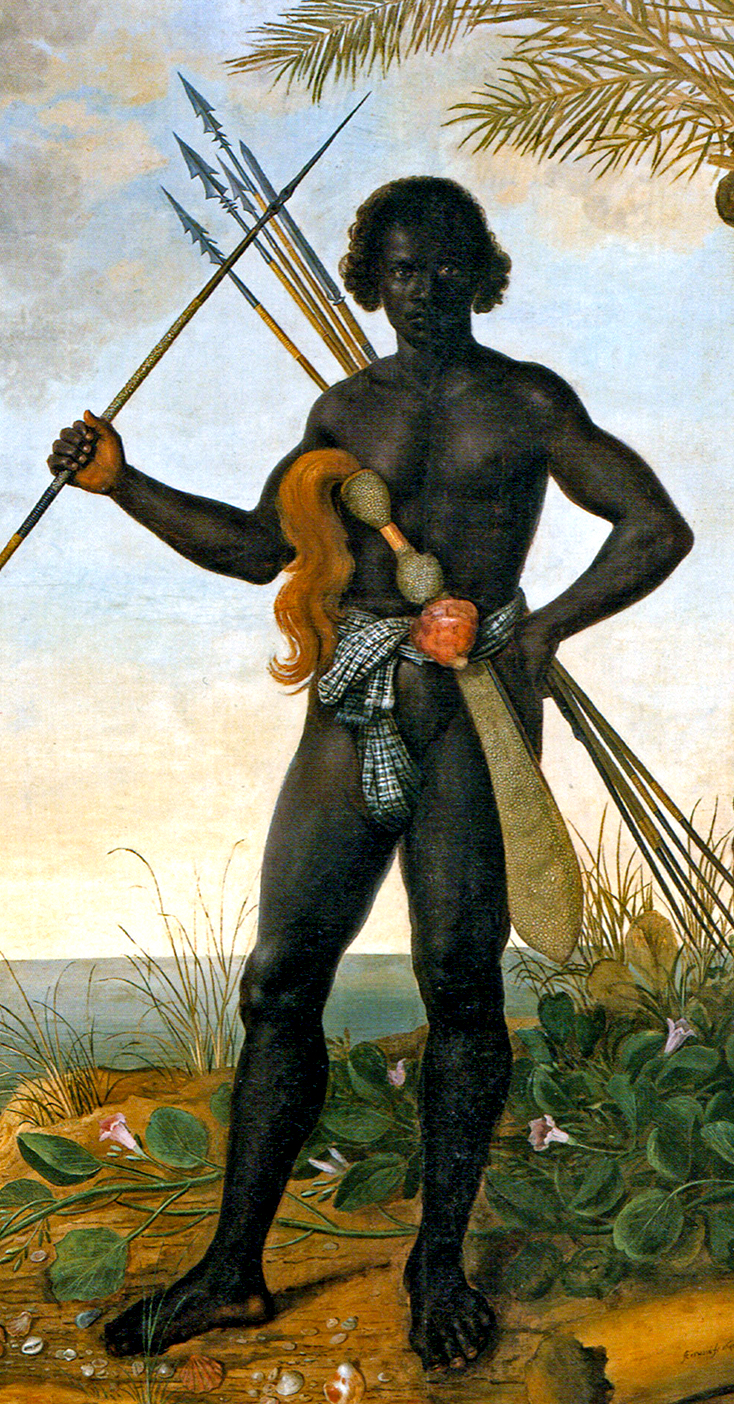 A 1641 painting depicting a leader of the Quilombo dos Palmares / Image: public domain
A 1641 painting depicting a leader of the Quilombo dos Palmares / Image: public domain
Hundreds of thousands died from hard labour in the silver and gold mines, in the Caribbean, in Mexico, and in Potosí. The conquest of America and the extermination of large numbers of the local population led to the massive development of the slave trade, not only in the Caribbean islands, but also in Brazil, Colombia, Ecuador, etc. Millions of Black people were captured in Africa and transported in inhuman conditions. Those who survived the Middle Passage were worked to death in the sugar cane and tobacco plantations.
But as noted, this was not a one-sided process. There was resistance, lasting for centuries. Rebellions, guerrilla wars lasting for decades, the establishment of free maroon communities (quilombos or palenques) of escaped slaves known as cimarrones, etc. In Brazil, for instance, under Portuguese colonial domination, we saw the formation of the Quilombo dos Palmares, where about 15,000 escaped slaves lived, which resisted from 1580 until its final descruction in 1710. In present-day Colombia, the town of San Basilio de Palenque traces its roots back to 1599, when Benkos Biohó, a black slave from present-day Guinea Bissau, escaped and fought a protracted war against the Spaniards, attacking slave ships arriving in Cartagena. In present day Ecuador, there was the Zambo Kingdom in Esmeraldas, established by African slaves who escaped when the ship transporting them ran aground after a storm in 1533. They joined and mixed with the local Indigeneous peoples (hence the name zambo, which described people of mixed Black African and Indigenous descent) creating a community free from Spanish colonial domination, which was finally officially recognised in the 18th Century. In present day Mexico, in 1570, escaped slaves led by Gaspar Yanga founded a free city in Veracruz, which they called San Lorenzo de los Negros, which was never defeated. Those peoples that lived in nomadic hunter-gatherer societies organised in kinship groups, like the Mapuche to the south of the Inca empire in present-day Chile; the Chichimeca to the north of the Mexica empire in present-day Mexico; and the Ava Guaraní to the east of the Inca empire in what is today Bolivia, waged courageous guerrilla wars. They made use of the elements of warfare that had given the Spanish an initial advantage, adopting the horse and firearms in particular. The fact that they did not produce an economic surplus and therefore had no previous experience of being subjugated under a state formation only increased their resilience to colonisation. They held back the conquistadors for decades, and in the case of the Mapuche, led by Lautaro and other toki [war time leaders], they actually defeated them and forced them to sign a peace deal favourable to the Mapuche.
Initially, the Spanish conquistadors adopted some of the external forms of the tribute system pre-existing among the Mexica and the Inca for their own purposes. Thus, the mit'a labour tribute of the Inca was used to force the ayllu to send labourers to the silver mines of Potosí. The tribute imposed on the calpulli in Mexico was now paid to the Crown. Spaniards married into the ruling families of the Inca and the Mexica in order to give a semblance of legitimacy to their rule.
While the external form of exploitation was the same, and the old agricultural commune even continued existing for a period of time (now paying tribute to the Crown), the real content was completely different. The mit’a was no longer a collective labour tribute for carrying out public works, which to a certain extent benefited the community, but rather it was used to extract silver from the mines, which was then syphoned off into the stream of world trade and the process of primitive accumulation of capital. It had become something more like the feudal corvée, only intensified to an unbearable degree.
Marx commented on this process in Capital when he wrote:
“It is, however, clear that in any given economic formation of society, where not the exchange-value but the use-value of the product predominates, surplus-labour will be limited by a given set of wants which may be greater or less, and that here no boundless thirst for surplus-labour arises from the nature of the production itself. Hence in antiquity over-work becomes horrible only when the object is to obtain exchange-value in its specific independent money-form; in the production of gold and silver. Compulsory working to death is here the recognised form of over-work.” [9]
How the conquest shaped Spain
In the first decades of the colonisation, there were conflicts between the conquistadors and the Spanish Crown. The conquistadors wanted the loot for themselves and were prepared to work the Indigenous peoples to death. But the Crown was interested in the steady, long-term flow of tribute and wary of the power of the conquistadors.
This conflict was dressed in the cloak of a religious debate between Dominican friar de las Casas, and the humanist scholar Sepulveda in 1550. They debated in Valladolid over questions such as the rights of the Indians, whether they had a soul, whether they were creatures of God, and if they could be evangelised. De las Casas won the debate, and this led to the Crown issuing laws that protected the Indians, although in name only. The conquistadors in Perú and Mexico rebelled against these laws, and they ended up having little real application.
But in the long term, Spain did not benefit from its American spoils. On the contrary, the enormous amount of loot extracted from America strengthened the monarchy, and was used to fund reactionary religious wars in Europe, luxury consumption, and state indebtedness. Spain had a massive balance of trade deficit which was constantly being financed with the gold and above all silver from America.
Even before the bulk of the spoliated American riches had arrived, the Crown had borrowed large amounts of money from south German and north Italian bankers, who charged extortionate interest rates. Chiefly amongst them was the Fugger family, which had originally lent King Charles I 600,000 ducats to secure his election as Emperor of the Holy Roman Empire. The Welsers were another family of German bankers who were granted rights over the province of Venezuela, as well as a dominant position in the slave trade, in exchange for loans they made to the Emperor.
The defence of its European possessions became increasingly costly, forcing King Charles to pay ever larger mercenary armies. In 1539 the Crown owed a million ducats to the bankers Fugger, Welser, Schatz and Spínola, by 1551 the figure had risen to 6.8 million. In 1556, exhausted and out of money, Charles V abdicated. The following year, his successor Philip II, who had inherited his debts, was forced to declare bankruptcy – the first of nine bankruptcies that Spain resorted to between 1557 and 1666.
American gold and silver also gave the monarchy a source of income that gave it greater independence from the nascent bourgeoisie in the cities. The Spanish Crown, having acquired a steady source of income outside of Spain, went on to smash the rebellion of the comuneros in Castile (1520-22), a bourgeois social revolt of the towns against the privileges of the nobility and the foreign King, as well as the rebellion of the Germanies in Valencia and Mallorca (1519-23), a movement of weavers, artisans and spinners. The green shoots of capitalist development were uprooted before they had a chance to flourish.
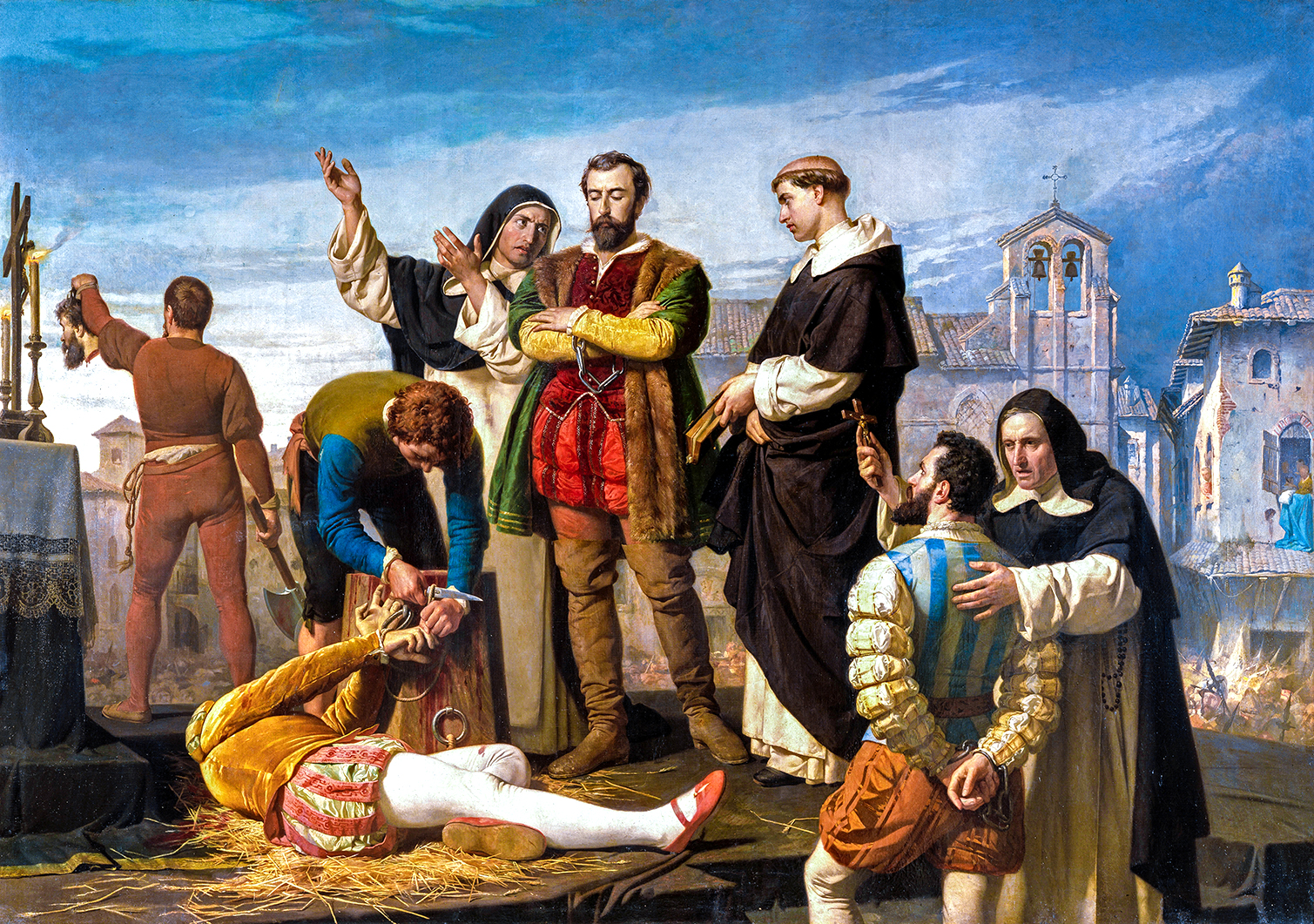 Antonio Gisbert, Execution of the Comuneros of Castile (1860) / Image: public domain
Antonio Gisbert, Execution of the Comuneros of Castile (1860) / Image: public domain
Earlier on, in 1492, the expulsion of Jews from Spain had already deprived the country of skilled artisans and sources of capital that could have given an impulse to early capitalism and the development of the economy in the towns.
A century later, in 1609, Felipe III decreed the expulsion of the Moriscos, Spanish Muslims who had been forced to convert. Perhaps as many as 300,000 (4 percent of the country’s population at the time) were forced out, which had a severe impact on the agriculture of Valencia and Aragón.
Spain was dominated by an idle nobility, dedicated to pursuing reactionary religious wars, spending hand over fist in luxury consumption. This was not a fertile soil for bourgeois development, quite the opposite.
Primitive accumulation
Between 1503 and 1660, 185 tonnes of gold and 16 million tonnes of silver arrived from America to the port of Seville, in Spain. The amount of silver transported to Spain in about a century and a half was three times the total European reserves at the time. These figures do not include what was lost through contraband and piracy.[10] The enormous amount of gold and silver coming into Europe produced a massive devaluation of all currencies (manifesting itself in runaway inflation). At the same time, awash with cash, Spain proceeded to import all sorts of manufactured goods, asphyxiating the national development of industry. The loot from America was syphoned off into the process of primitive capitalist accumulation elsewhere (Holland and England) and sealed Spain’s backwardness for several centuries.
Additionally, this meant that no real economic development took place in the Americas, or at least it took place very slowly. While the surplus extracted by feudal lords from peasants in Europe was used in Europe in one way or another, the surplus extracted by the Spanish colony from America was not used locally in any way, but funnelled out into the circuit of nascent capitalism in Europe. This solidified the subordinate place of Latin America in the world division of labour. The local ruling classes, even though they achieved independence from Spain in the 19th Century, were never able to play a really progressive role. They went from being dominated by the Spanish Empire, to falling into the orbit of other imperialist powers: England, but above all the United States.
As well as driving the primitive accumulation of capital, the conquest of America created the modern world market. Commerce developed with China, through the Spanish colony of the Philippines, via America, fuelling a powerful current of commercial exchange. The world was united under the rule of trade, heralding the birth of world capitalism as Marx and Engels explained in the Communist Manifesto:
“The discovery of America, the rounding of the Cape, opened up fresh ground for the rising bourgeoisie. The East-Indian and Chinese markets, the colonisation of America, trade with the colonies, the increase in the means of exchange and in commodities generally, gave to commerce, to navigation, to industry, an impulse never before known, and thereby, to the revolutionary element in the tottering feudal society, a rapid development.”[11]
In Anti-Dühring Engels makes the same point: “American gold and silver flooded Europe and forced its way like a disintegrating element into every fissure, rent and pore of feudal society. Handicraft industry could no longer satisfy the rising demand, in the leading industries of the most advanced countries it was replaced by manufacture.”[12]
The brutal, bloody process of the Spanish conquest of the Americas, which led to the massive extermination of the Indigenous peoples that lived in the continent, and the large-scale destruction of their cultural achievements, was an integral part of the creation of world capitalism.
It led Marx to declare: “If money, according to Augier, ‘comes into the world with a congenital blood-stain on one cheek,’ capital comes dripping from head to foot, from every pore, with blood and dirt.”[13]
But the development of capitalism and the world market also created a world working class, the class which is destined to be the grave-diggers of this brutal system of oppression and exploitation.
References
[1] P Martire D'Anghiera, F MacNutt (trans.), De Orbe Novo, Volume 1, Project Gutenberg, 1912, book III
[2] A note on spelling. The most common spelling of Inca in English is with “c”, coming from the Spanish transliteration of the original Kichwa which they spoke. More recently a new standard transliteration of the language has been adopted in which a “k” is used instead, Inka. Here we have kept Inca for the name of the civilisation, but Inka when it refers to the name of a particular ruler or the office.
[3] A note on terminology. Aztec refers to several peoples who come from the legendary land of aztlán and who share the common Nahua language. This is the term which was used by historians starting in the 18th Century and has become common use in the English language. Mexica refers to those peoples who left aztlán and adopted the god Huitzilopochtli (also known as Mexi). The Mexica went on to found two cities, Mexico-Tlatelolco and Mexico-Tenochtitlan, whose inhabitants were known as tlatelolcas and tenochcas respectively. In this text, we will use ‘Mexica’ throughout to refer to the people of Tenochtitlan who dominated the Triple Alliance and the society they created.
[4] A Woods, Reformism or Revolution: Marxism and socialism of the 21st Century (Reply to Heinz Dieterich), Wellred Books, 2015, pg 54
[5] G Urton, Signs of the Inca Khipu: Binary Coding in the Andean Knotted-String Records. Austin: University of Texas Press, 2003.
[6] F Engels, The Decline of Feudalism and the Rise of the Bourgeoisie, Monthly Review, April 1957, pg 445-454
[7] B De las Casas, A Short Account of the Destruction of the Indies, Penguin Classics, 1992, pg 15-16
[8] F López de Gómara, La Conquista de México, Dastin Historia, 2000, pg 158-160, our translation
[9] K Marx, Capital Volume 1, Progress Publishers, 1954, pg 164
[10] E Galeano, Las Venas Abiertas de América Latina, SXXI editores, 1971, pg 34
[11] K Marx, F Engels, “The Communist Manifesto”, The Classics of Marxism vol 1, WellRed Books, 2013, pg 4
[12] F Engels, Anti-Dühring, WellRed Books, 2017, pg 126
[13] K Marx, Capital Volume 1, Penguin Books, 1976, pg 925-26

